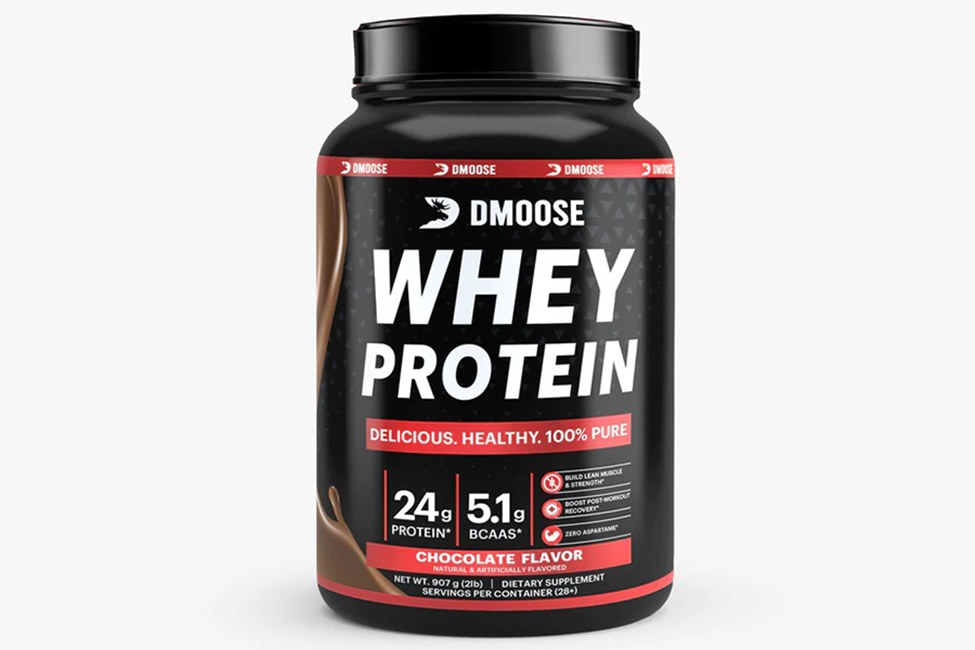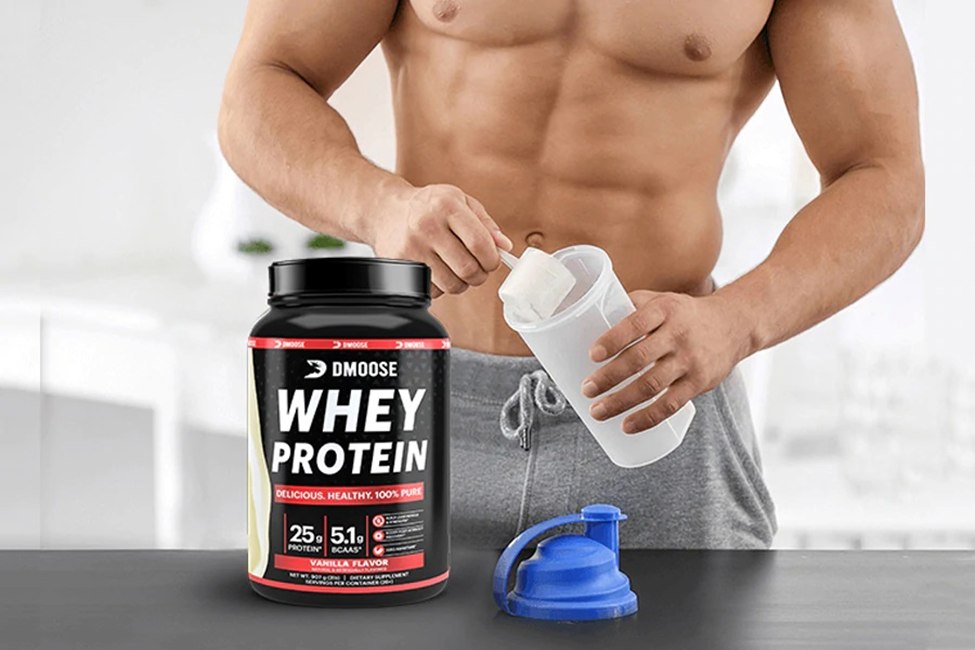Whey Protein Powder can be a quick and easy way to ensure your body is well-nourished and satisfied completely. They are used for many purposes, such as weight loss, sports performances, muscle building, and overall wellness.
But, before getting to know which protein powder is suitable for you, you should first understand why consuming optimum protein is essential in the first place.
Protein powder is essential as it helps you hit your protein goals when it becomes impossible for you to meet your protein daily recommended requirement with food alone.
According to a study, the minimum amount of protein a person with minimum physical activity needs is 0.8g per kilogram (kg) or 0.36g per pound. This demonstrates that a 160-pound individual needs approximately 58 grams of protein to prevent protein deficiency.
For an estimate, a palm of protein contains approximately 20 to 30 grams of protein. You would need to eat 2 to 3 portions of pure protein per day, such as chicken breast, Greek yogurt, or legumes.
If you don’t get enough protein, it can cause you to lose muscle mass, resulting in slow metabolism. You also have problems with hair, skin, and nails. In addition, the healing process slows down if you get cuts or bruises, and you are also more likely to break your bones easily.
In contrast, there are many benefits of consuming whey protein as a dietary supplement unless you don’t have any medical reason to keep your protein intake low. It’s especially true if you are a fitness freak and want to gain strength and muscle mass.
Table of Contents
Reasons for Using Whey Protein Powder

Here are just a handful of the many reasons why you should use whey protein powder to boost your fitness level:-
Appetite Control
Different studies have proved that protein aids in reducing hunger and appetite. It is because protein helps keep you fuller for an extended period than any other macronutrient.
Higher protein consumption also results in the release of satiety hormones such as GLP-1 and PYY.
It is also believed that whey protein is digested quickly, rapidly increasing the amino acid level in the blood. This will, in turn, suppress the food intake.
Weight and Body Composition Management
If you are tiresome to lose weight, high protein intakes can help you eat less, increase your metabolism through the thermic effect of food, and preserve muscle during fat loss. Due to its thermic effect, a high protein diet has enhanced metabolism and increased daily calorie consumption by 80 to 100 calories.
Muscle Growth or Maintenance
Protein supplementation paired with exercise helps you grow and maintain muscle mass, especially as you get older. Protein is madeup of amino acids, the building blocks for muscle.
While your body can produce many amino acids, you can only attain the nine essential amino acids (EAA) from meat, beans, nuts, and soy foods. Mixed amino acids are an excellent way to increase muscle protein synthesis.
Leucine is an amino acid responsible for many muscle-building (anabolic) processes. This is called the “leucine trigger concept” because sufficient leucine levels trigger muscle protein production. Because the amino acids (the building blocks) help maintain and repair muscle tissue, protein is essential in building muscle.
Better Strength
Consuming an adequate amount of protein along with exercise results in gaining strength. Although, If you are physically active, lifting weights, or growing muscle, you need to eat enough protein. Maintaining a high protein intake during weight loss can also assist in preventing muscle loss, thus enhancing strength.
Improved Immune Function
Antibodies are made up of proteins, which serve various functions in the immune system. Protein deficiency makes people more exposed to viral and bacterial illnesses.
Because it contains amino acids, as mentioned above, whey protein has strong antioxidant properties. Immune function is improved when there is a high quantity of these amino acids in the body because they are converted to glutathione inside the cells (GSH).
Glutathione is a critical component of the body’s antioxidant defence mechanism, which shields cells from free radical damage, pollution, toxins, and illness. Glutathione levels drop as we age and get sick.
Compared to other protein sources, whey has the unique ability to boost glutathione production, which contributes to better health overall.
Faster Exercise Recovery
Higher protein consumption helps repair tissue damage during exercise and after an injury. After training, most athletes and bodybuilders consume whey protein drinks. These solutions fuel your body while providing essential amino acids for muscle repair.
They also help prevent muscle damage. However, there is no recent evidence that protein may directly help in recovery, but it may benefit because it helps maintain lean muscle mass and strength while losing fat. This is especially helpful for individuals on a diet or preparing for a competition.
So now, when you know many of the benefits of consuming whey protein supplements, let us see how you can choose the best whey protein for your fitness and strength.
Tips for Choosing Whey Protein Powder
There are numerous kinds of protein powders available in the market, and every day, a new one pops up. You may also find many plant-based protein powders available (peas and hemp, soy, etc.), which can be great alternatives for those who do not eat animal products.
However, here, we will concentrate on the two big elephants of the industry: casein and whey.
There are two kinds of Whey Protein: isolate and concentrate.
Whey Protein Concentrate
This is a common form of whey protein found in most products on our shelves. Whey concentrate and casein are byproducts of the dairy processing process.
Whey concentrate is described as the most biologically-efficient protein for the human body to absorb. After the cheese is removed, the concentrate is filtered and ground into a powder. This concentrate is easier to mix with liquids and has a smoother texture and flavour in protein shakes than isolate.
However, there are also some downsides to using Whey Concentrate. This protein powder is more likely to contain sugar and fat than whey isolate. Similarly, if you have lactose intolerance, you may experience stomach problems.
Whey Protein Isolate
Whey Isolate begins as whey concentrate. It then further gets filtered and more refined. After most fats and carbs have been removed, whey isolate is left as a concentrated protein.
The powder is also freed from lactose, making it more suitable for lactose-intolerant people. The extra processing makes the powder a better source of protein than the 80% found in whey concentrate.
There are some drawbacks to isolate as well. It can be more expensive than concentrate. The powder will also require more ingredients to make it easier to mix.
There is another protein type, known as casein protein. It is the other byproduct of cheese making (other than water). Casein is processed the same as whey and then filtered to about 80% protein.
The body absorbs casein protein differently from the other two protein types, the most crucial difference. Because of its complex structure, the body takes casein protein longer to digest than whey.
How to Choose the Right Whey Protein Powder?
You should study the following factors when choosing the most suitable whey protein powder for yourself:
Quality
Let’s take a look at the ratio of protein and filler in the protein powders you can find at your local grocery store or supplement shop to identify the quality. It is as simple as this:
(grams per serving of protein/total grams per serving) X 100
= The percentage of protein contained in a meal
This equation will tell you how much protein each scoop contains. The higher the supplement’s percentage, the higher the quality, the fewer fillers it contains.
Examples:
Protein A: 47.2g serving size, 22g protein per serving = 47%
Protein B: 31g serving size, 24g protein per serving = 77%
These proteins may look similar, but if we dig deeper, we discover that Protein B contains 30% more protein than Protein A. This is quite a lot.
Protein A may indeed taste better, but that’s because you are spending money on products that don’t help you reach your goals.
Tip: Look for at least 50% protein per serving. This will give you the most return on investment and will usually result in more servings per container.
Taste
For satisfying your taste buds, find what you love and what you can consume in the long run. You can start with the smallest container possible or buy sample packs. This will help you discover what you like and not make you buy a huge tub of powder that you won’t enjoy later.
Price
Instead of focusing only on the total cost of the container or its size, consider the cost per serving. While two tubs of protein may appear almost identical in terms of their size, shape, weight, and value, they will have drastically different results when you break them down.
For instance:
Protein A: $19.99, 2 lbs. total weight, 24g per serving, 20 servings
Protein B: $22.99, 2 lbs. Total weight, 24g per serving, 28 servings
Both options look identical and have the same weight and protein content. We will choose the cheaper option. But it is not as it looks. If you save $0.18 per serving with protein B, f you will save about $130 annually.

Considering the factors for choosing the best whey protein, DMOOSE offers whey protein concentrate and whey protein isolate at affordable prices.
It contains essential amino acid building blocks for new muscle production, better strength, fitness, and immunity.
Conclusion
Whey protein plays an essential role in meeting the daily recommended protein requirement, especially for people in the fitness industry. You need to consume 15-25 grams of protein with each meal that cannot be fulfilled if you do not consume a protein-rich diet.
Many types of research on whey protein supplements prove their benefits for muscle building and strength. It also helps control appetite, maintain muscles, and recover after workouts. Choosing the suitable whey protein powder for your requirements is not difficult. You need to have the required information to select your protein powder. Do not forget to read the label carefully for its quality, price, and ingredients before purchasing.
References
-
- de Carvalho, Kênia M. B., et al. “Dietary Protein and Appetite Sensations in Individuals with Overweight and Obesity: A Systematic Review.” European Journal of Nutrition, vol. 59, no. 6, Sept. 2020, pp. 2317–32. PubMed, https://doi.org/10.1007/s00394-020-02321-1.
- Dröge, W., and R. Breitkreutz. “Glutathione and Immune Function.” The Proceedings of the Nutrition Society, vol. 59, no. 4, Nov. 2000, pp. 595–600. PubMed, https://doi.org/10.1017/s0029665100000847.
- Halton, Thomas L., and Frank B. Hu. “The Effects of High Protein Diets on Thermogenesis, Satiety and Weight Loss: A Critical Review.” Journal of the American College of Nutrition, vol. 23, no. 5, Oct. 2004, pp. 373–85. PubMed, https://doi.org/10.1080/07315724.2004.10719381.
- Helms, Eric R., et al. “A Systematic Review of Dietary Protein during Caloric Restriction in Resistance Trained Lean Athletes: A Case for Higher Intakes.” International Journal of Sport Nutrition and Exercise Metabolism, vol. 24, no. 2, Apr. 2014, pp. 127–38. PubMed, https://doi.org/10.1123/ijsnem.2013-0054.
- Pasiakos, Stefan M., et al. “Effects of Protein Supplements on Muscle Damage, Soreness and Recovery of Muscle Function and Physical Performance: A Systematic Review.” Sports Medicine (Auckland, N.Z.), vol. 44, no. 5, May 2014, pp. 655–70. PubMed, https://doi.org/10.1007/s40279-013-0137-7.
- Wilkinson, D. J., et al. “Effects of Leucine and Its Metabolite β-Hydroxy-β-Methylbutyrate on Human Skeletal Muscle Protein Metabolism.” The Journal of Physiology, vol. 591, no. 11, June 2013, pp. 2911–23. PubMed, https://doi.org/10.1113/jphysiol.2013.253203.
- Wu, Guoyao. “Dietary Protein Intake and Human Health.” Food & Function, vol. 7, no. 3, Mar. 2016, pp. 1251–65. PubMed, https://doi.org/10.1039/c5fo01530h.

